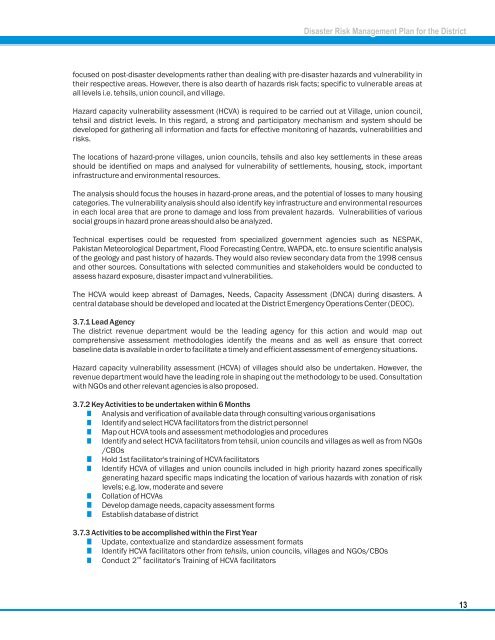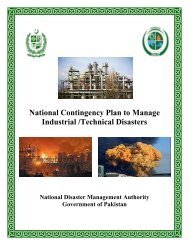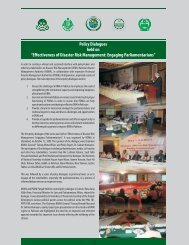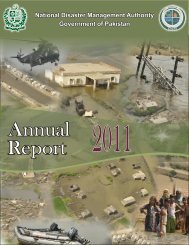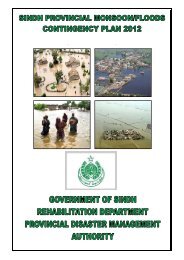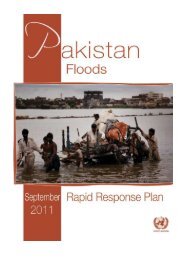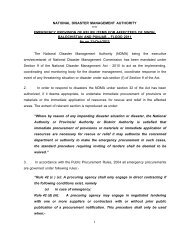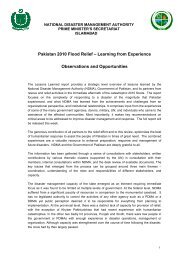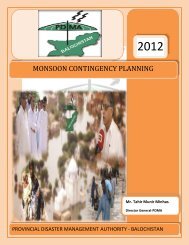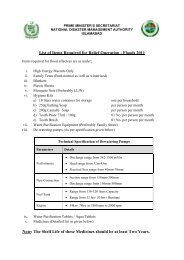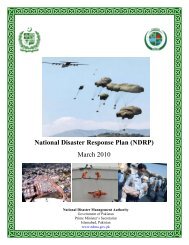District Disaster Management Plan District Kech, Balochistan - NDMA
District Disaster Management Plan District Kech, Balochistan - NDMA
District Disaster Management Plan District Kech, Balochistan - NDMA
You also want an ePaper? Increase the reach of your titles
YUMPU automatically turns print PDFs into web optimized ePapers that Google loves.
<strong>Disaster</strong> Risk <strong>Management</strong> <strong>Plan</strong> for the <strong>District</strong><br />
focused on post-disaster developments rather than dealing with pre-disaster hazards and vulnerability in<br />
their respective areas. However, there is also dearth of hazards risk facts; specific to vulnerable areas at<br />
all levels i.e. tehsils, union council, and village.<br />
Hazard capacity vulnerability assessment (HCVA) is required to be carried out at Village, union council,<br />
tehsil and district levels. In this regard, a strong and participatory mechanism and system should be<br />
developed for gathering all information and facts for effective monitoring of hazards, vulnerabilities and<br />
risks.<br />
The locations of hazard-prone villages, union councils, tehsils and also key settlements in these areas<br />
should be identified on maps and analysed for vulnerability of settlements, housing, stock, important<br />
infrastructure and environmental resources.<br />
The analysis should focus the houses in hazard-prone areas, and the potential of losses to many housing<br />
categories. The vulnerability analysis should also identify key infrastructure and environmental resources<br />
in each local area that are prone to damage and loss from prevalent hazards. Vulnerabilities of various<br />
social groups in hazard prone areas should also be analyzed.<br />
Technical expertises could be requested from specialized government agencies such as NESPAK,<br />
Pakistan Meteorological Department, Flood Forecasting Centre, WAPDA, etc. to ensure scientific analysis<br />
of the geology and past history of hazards. They would also review secondary data from the 1998 census<br />
and other sources. Consultations with selected communities and stakeholders would be conducted to<br />
assess hazard exposure, disaster impact and vulnerabilities.<br />
The HCVA would keep abreast of Damages, Needs, Capacity Assessment (DNCA) during disasters. A<br />
central database should be developed and located at the <strong>District</strong> Emergency Operations Center (DEOC).<br />
3.7.1 Lead Agency<br />
The district revenue department would be the leading agency for this action and would map out<br />
comprehensive assessment methodologies identify the means and as well as ensure that correct<br />
baseline data is available in order to facilitate a timely and efficient assessment of emergency situations.<br />
Hazard capacity vulnerability assessment (HCVA) of villages should also be undertaken. However, the<br />
revenue department would have the leading role in shaping out the methodology to be used. Consultation<br />
with NGOs and other relevant agencies is also proposed.<br />
3.7.2 Key Activities to be undertaken within 6 Months<br />
Analysis and verification of available data through consulting various organisations<br />
Identify and select HCVA facilitators from the district personnel<br />
Map out HCVA tools and assessment methodologies and procedures<br />
Identify and select HCVA facilitators from tehsil, union councils and villages as well as from NGOs<br />
/CBOs<br />
Hold 1st facilitator's training of HCVA facilitators<br />
Identify HCVA of villages and union councils included in high priority hazard zones specifically<br />
generating hazard specific maps indicating the location of various hazards with zonation of risk<br />
levels; e.g. low, moderate and severe<br />
Collation of HCVAs<br />
Develop damage needs, capacity assessment forms<br />
Establish database of district<br />
3.7.3 Activities to be accomplished within the First Year<br />
Update, contextualize and standardize assessment formats<br />
Identify HCVA facilitators other from tehsils, union councils, villages and NGOs/CBOs<br />
nd<br />
Conduct 2 facilitator's Training of HCVA facilitators<br />
13


